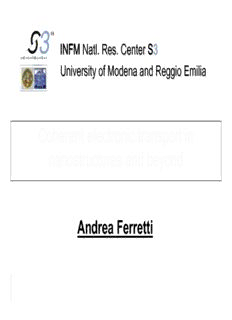
Coherent electronic transport in nanostructures and beyond PDF
Preview Coherent electronic transport in nanostructures and beyond
IINNFFMM NNaattll.. RReess.. CCeenntteerr SS33 UUnniivveerrssiittyy ooff MMooddeennaa aanndd RReeggggiioo EEmmiilliiaa Coherent electronic transport in nanostructures and beyond Andrea Ferretti Acknowledgments PPeeooppllee @@ SS33:: EExxtteerrnnaall CCoollllaabboorraattoorrss:: Andrea Ferretti Arrigo Calzolari Carlo Cavazzoni Marco Buongiorno Nardelli (NCSU, US) Nicola Marzari (MIT, US) Rosa Di Felice Marilia J. Caldas (USP, Brazil) Franca Manghi Elisa Molinari National Research Center on S S S nano tructures and bio ystems at urfaces via Campi 213/A, 41100 Modena, Italy Outline Motivations (cid:139) The method (cid:139) Ab initio electronic transport from max. loc. Wannier Functions: • Development • Implementation (WanT code) • Application to nanoscale systems Inclusion of correlation (cid:139) in transport Application to short range e-e interaction regime Motivations ♦ Novel systems for electronic devices (nanotubes, atomic chains, molecular systems,…) M. Reed et al., Science (1997) H. Ohnishiet Al.,Nature, 395, 780 (1998) C. Dekkeret Al., Nature 429, 389 (2004) D.Porath et al., Nature (2000) ♦ Semiclassical transport theory breaks down ♦ Full quantum mechanical approach (cid:198) Landauer Theory Ballistic transport Conductance as transmission through a nano-constriction ♦Ballistic transport: exclusion of non-coherent effects (e.g. dissipative scattering or e-e correlation). ♦Quantum conductance: depends on the local properties of the conductor (transmission - scattering) and the distribution function of the reservoirs Landauer Formula ♦Transmittance from real-space Green’s functions techniques Fisher & Lee formulation ♦Need for a localized basis set The “WanT” approach Create a connection between ♦ ♦ab initio description of the electronic structure by means of state-of-the-art DFT- plane wave calculations ♦Real space Green’s function techniques for the calculation of quantum conductance. ♦Idea: Unitary transformation of delocalized Bloch-states into Maximally localized Wannier functions WanT method A. Calzolari, PRB 69, 035108 (2004). Wannier functions (WFs): definition Single band transformation: Generalized transformation: Non-uniqueness of WFs under gauge transformation U(k) mn Goal: Calculation of WFs with the narrowest spatial distribution Maximally localized Wannier functions* * N. Marzari, and D. Vanderbilt, PRB 56, 12847 (1997). Wannier functions: localization Spread functional Maximal localization given by the minimization of the spread wrt U: WF advantages: WF disadvantages: orthonormality no analytical form completness computational cost minimal basis set algorithm stability adaptability direct link to phys. prop. Flow diagram DDFFTT Conductor (supercell) Leads (principal layer) WWFFss GGFFss All quantities on Wannier basis Zero bias QQCC Linear response Quantum conductance WanT Code www.wannier-transport.org Features: • Input from PW-PP, DFT codes. • Maximally localized Wannier Functions computation. • Transport properties within a matrix GF’s Landauer approach. • GNU-GPL distributed
Description: